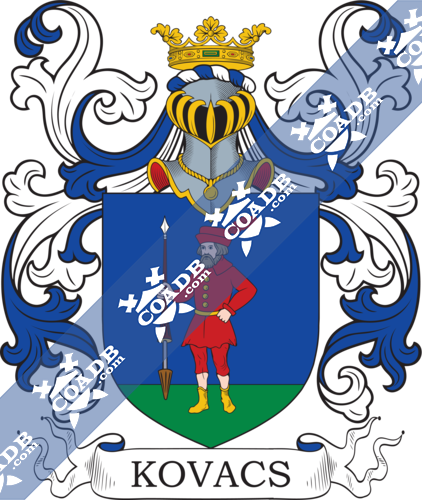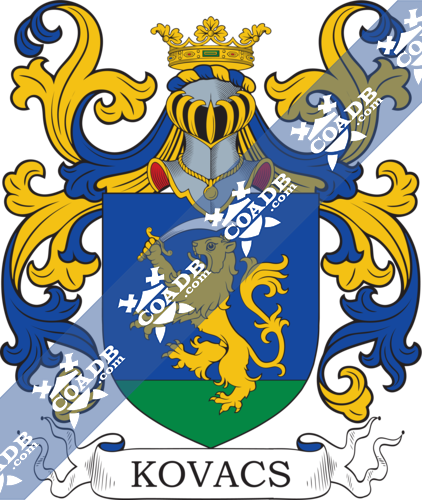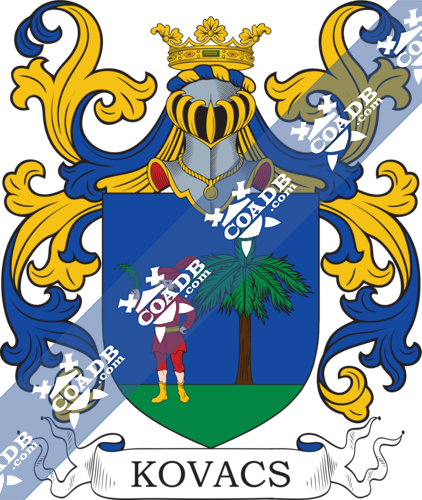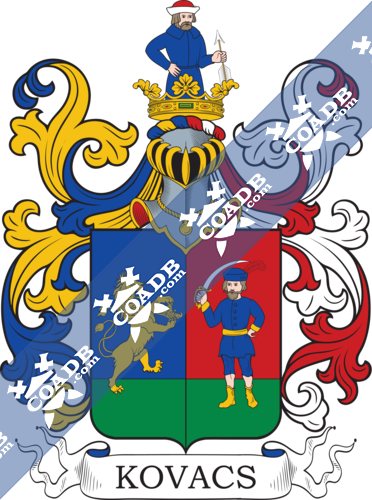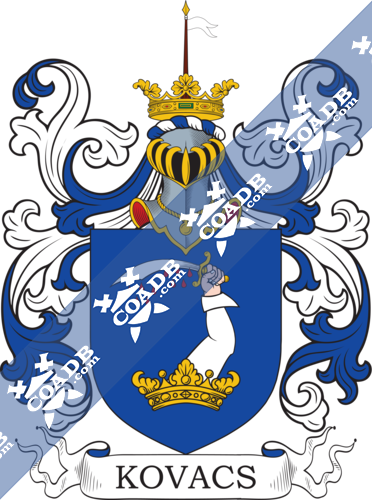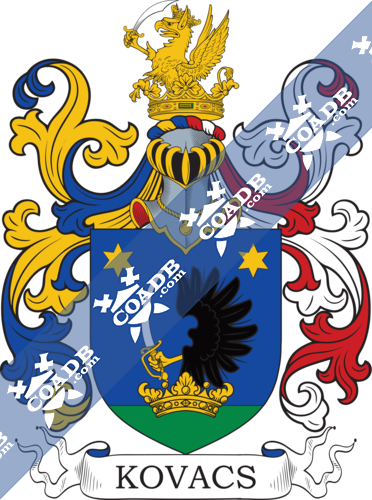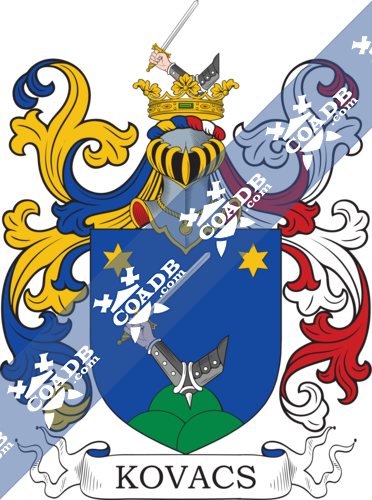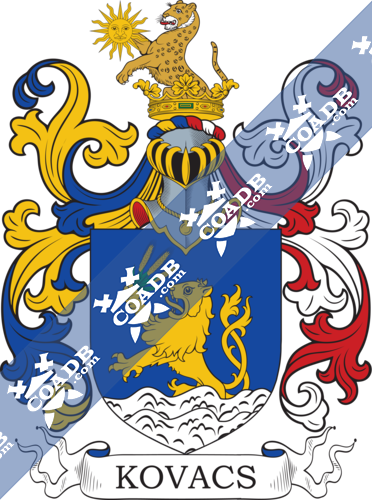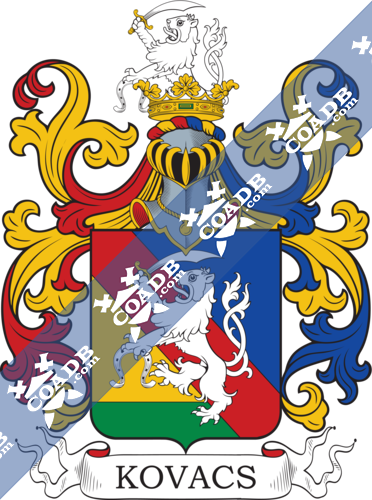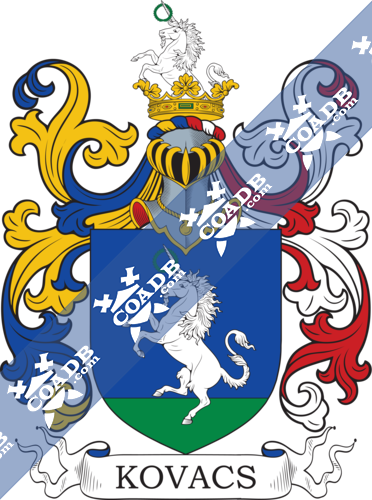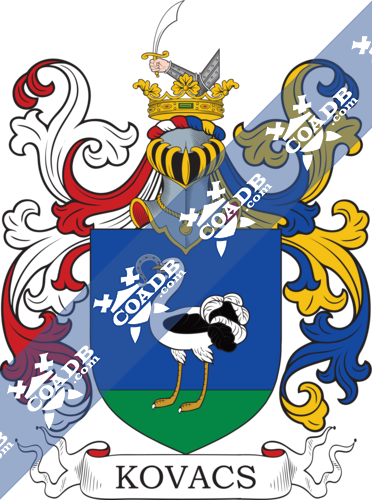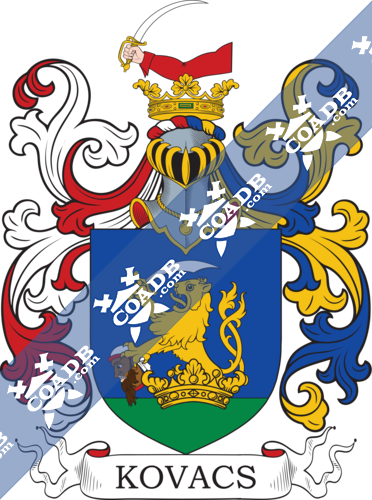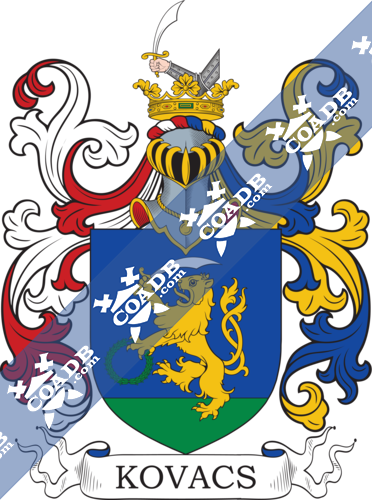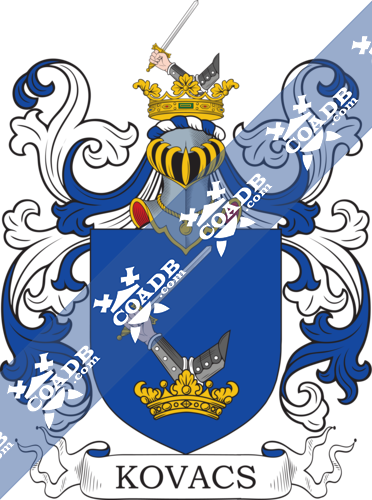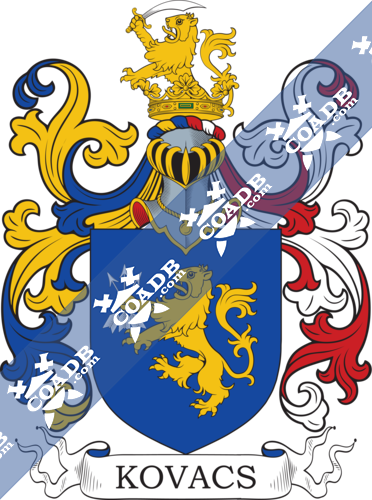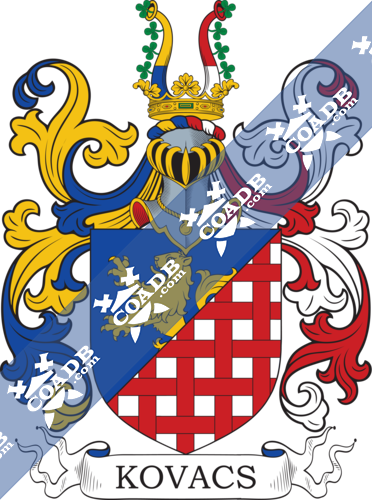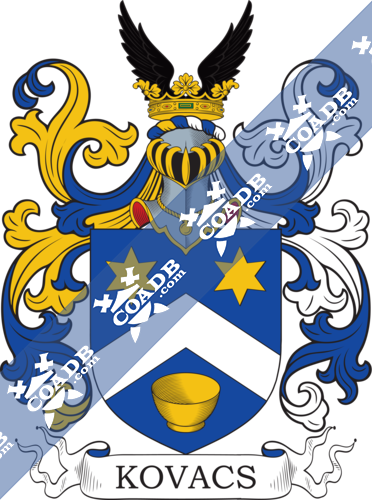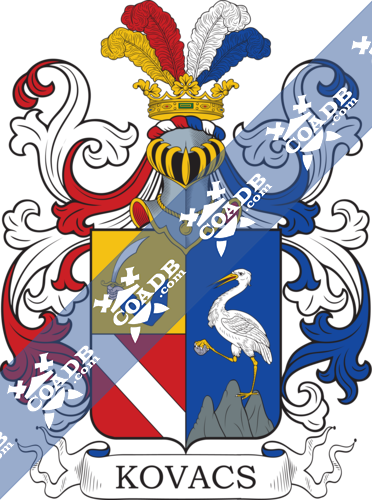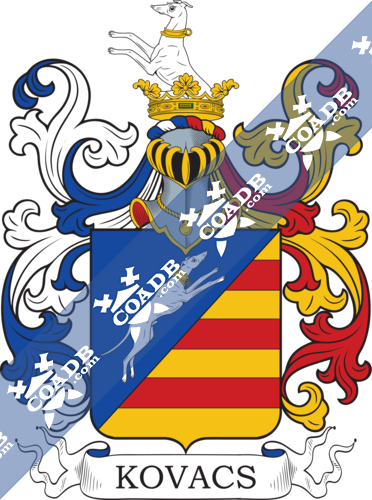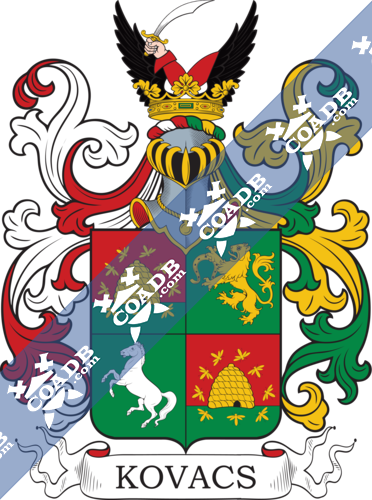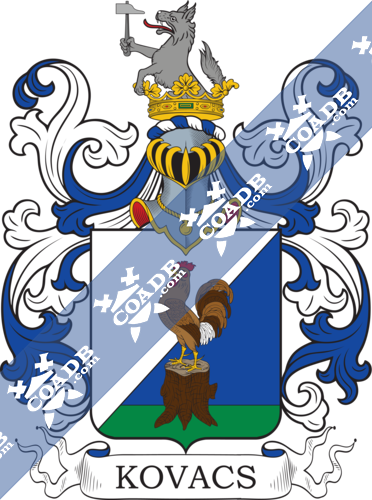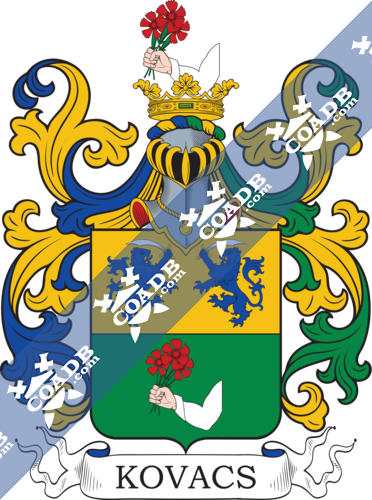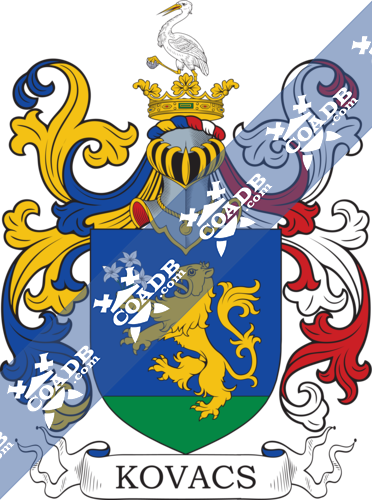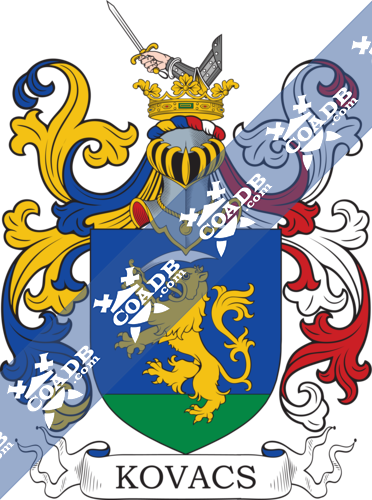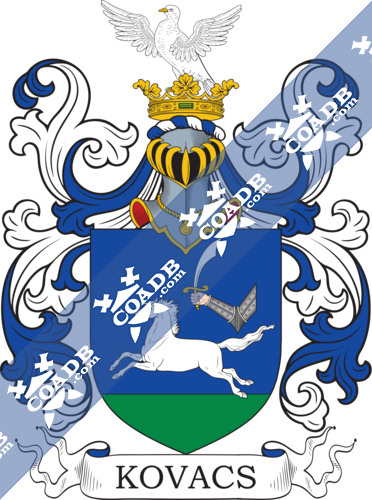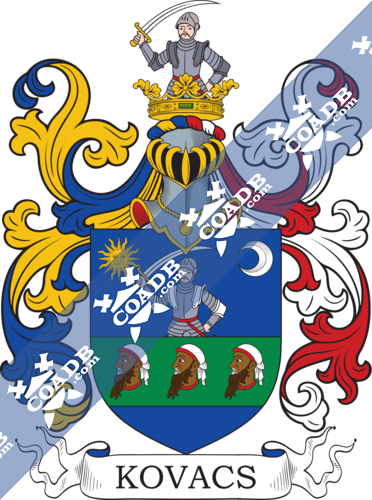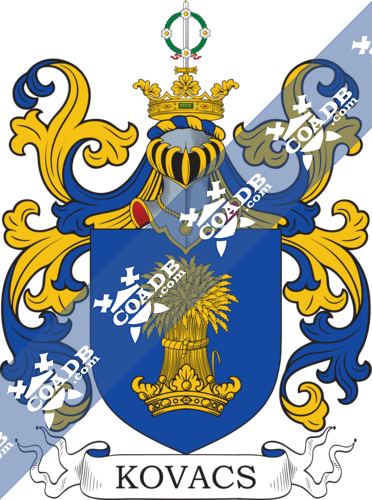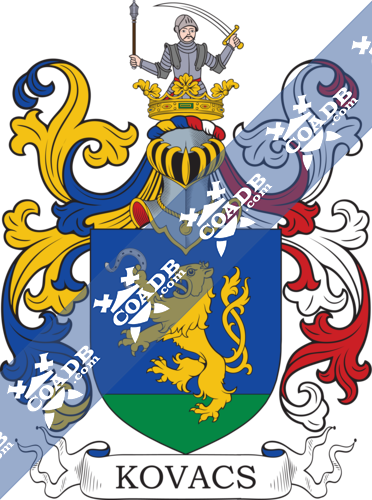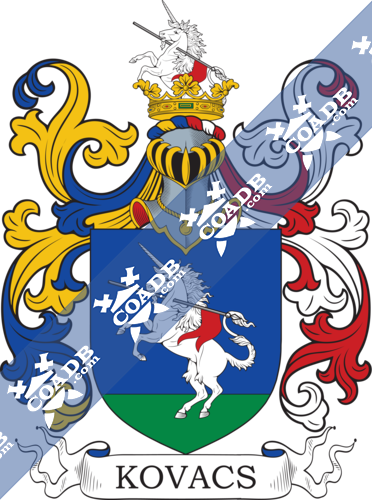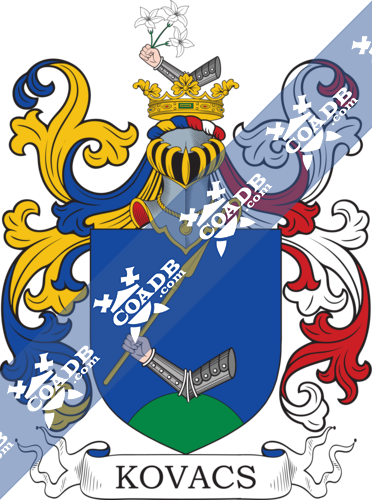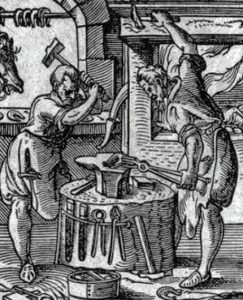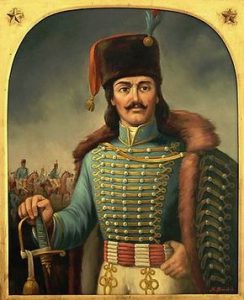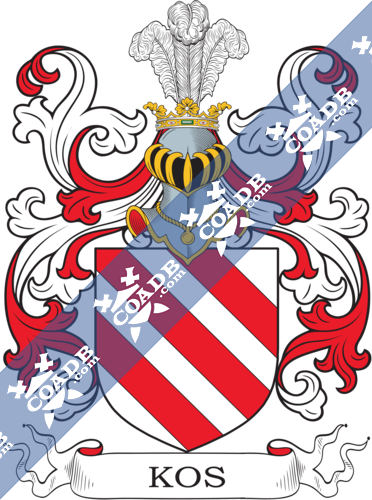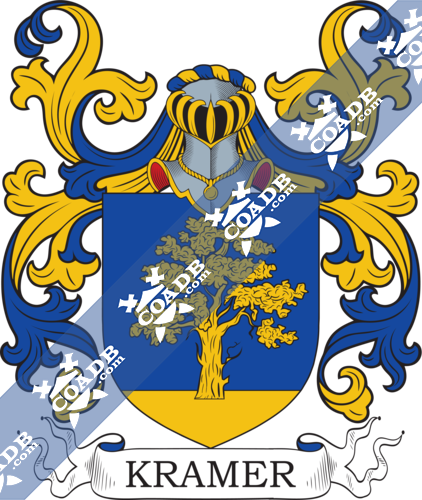Kovacs Family Crest, Coat of Arms and Name History
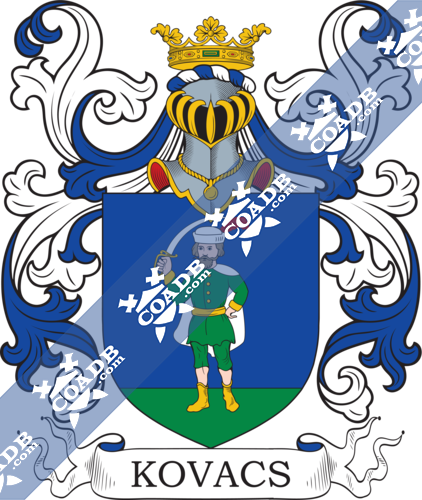
Kovacs Coat of Arms Gallery
Don’t know which Coat of Arms is yours?
We can do a genealogical research. Find out the exact history of your family!
Learn MoreMeaning, Origin, Etymology
The surname Kovač (Cyrillic: Ковач, Bulgarian: Ковачев; also transliterated Kovačev, Ukrainian: Коваль, translit. Koval’, ), originating before the 7th century word with the word ‘kowac’ meaning to forge, and hence is an occupational name that has a meaning of forger, smiths or blacksmith in Slavic languages, it is a very common surname in Croatia, Bosnia-Herzegovina, Hungary, Serbia, Slovakia, the Czech Republic and Slovenia. Outside Europe, the surname is fairly common in the United States, Canada, and South America. It is rumored that the most famous coat of arms and that was associated The Crusades of the 12th century to the Holy Land has the blazon of a red field charged with a broadsword, point down, between two Turkish crescents, all gold. It was meant to imply the victory over the Muslims, but historically can not be proven.
Spelling Variations
Kovats, Kovac, Kovat, Kovats, Kovach, Kowal, Koval, Kowalski, Kovalski, Kovel, Kofax, Kowalczyk, Kowalik, Kovaricek, Kovarik, Coval, Covali, Covaliov, Smith (some Smith lines were Kovacs)
Popularity & Geographic Distribution
The last name Kovacs ranks 9,611th in popularity worldwide as of the 2014 Census and approximately 59,267 people carry the Kovacs surname worldwide. The name ranks particularly high in the following six states: Ohio, California, New York, Florida, New Jersey and Pennsylvania. It ranks highest in the following countries: Romania (25,908), United States (12,574), canada (3,932), Germany (2,694), Hungary (2,615), Austria (2,264)
History, Genealogy & Ancestry
**This section has been translated online from Hungarian to English if there are parts that may not make sense we do apologize, source: MAGYARORSZAG CSALADAI CZIMEREKKEL**
Kovács family. (Járdánházi.) The Kovács is different from Járd or the Kovács family of pavilions, their ancestors or surnames Judged Borsod county origin after Járdánháza. It lies in Borsod county. Family in the last century in Bihar and Nógrád counties find. Their arms is in the blue court of the paiz, in a green, square, right hand holding a turkish head slapped on the tip of his sword. . Above-the-top From the corona of the helmet Deer rises. Waste from right side gold, from left to right silver-red. In the county of Nógrád from this family János Kovács was a deputy in 1711 volt. With Neja and Luka Mária founded such a family: Janos alispan 1711 (Luka, Maria), their children Ignacz 1756 fosz-bird, Borbala (Kelio, Adam), Terez (Piber, Jozsef). In 1756, Ignácz became a fictional judge in Nógrád county; and it was about 1763. István Kovács In 1770 the Nógrád County Department of Labor a from the Bosnyák family of the Puszta-Szántó family, to spread this sector: Isivan alszolgabird (Bornyak, Anna) their children are: Sandor, Laszlo and Anna (married Saubszky Istvan 1859 mart. 28). Children of Sandor are: Eduard, Cornelia, Josefa, Berialan, Emilia, Luiza, Benedek, Lajos, Agostou. On this family tree Anna was married to István Szubszky in 1798, died March 1859. On the 28th in the 84th year of his life, on his estate and residence P. -Santo. It was from this family that John was born in 1739. dec. In 1761, in the diósgyri chamber, was a writer, in 1768 he was a cashier, then a Oradea Inspired Inspector and finally Praefectus, in 1775 in Bihar county board dance. He died in Nagy-Váradi on March 1807. 25th. Neđl Jabródi from Mary Jabróczky (who was injured in 1793) His children are Anna Balek Károlyné sipeki and Magdolna nosziczi Thurzó Györgyné was 1). In the town of Szatmár, at the beginning of this century, this family is owned by Mátészalka, Pork, Sand, etc. 2).
Kovách family. (Leleszi and visontai.) Known Tribe János. In 1656 III. King Ferdinand won a noble letter from escutcheoned. Escutcheon in the blue courtyard of the paizs, with a twisted tangled green field lion, the horn head slapped on the tip of his sword with his right leg It holds. From the crown of the top of the paw, grif rises with his first right leg also holding a turkish head at the tip of a sword. Drop from the right gold-blue, silver-red on the left. The Kovács family in Leszesz has a family in Bolya and Heves county was József Kovács, Officer of 1838, son of his son Inv the n d in 1845 was an orphanage note. Mátyás was sworn in 1838 in the district of Mátyás. Gusztáv was in Heves County Counselor in 1845. From the Visonta branch, he worked in the county of Nógrád County, died In 1760; so the family was broken down. Pal (1760) (Szent-Ivanyi Kats) had the children: Antal (Nograd v. foazbird) (1790) (Szabo Borbals) and Jozsef (kir. Ugy aliganzg.)(1820)(Rinya-ujlaki Lada Jozefa). Jozsef’s children are: Jozsef (Nedeczky Maria) and Janos (1860) april 19 (P Gyorkon)(Latinovics Eszter). The child of Janos is Laszlo (lsk. P. Gyorkon (Mocsary Roza), Laszlo’s children are: Zoltan, Margit and Dezso. The son of Paul, Antal and Joseph, later became Kir. Deputy Director. In 1809, retaining their former arms is a royal possession of their visontai estate donate a donation and win a laugh at this right. János is also kir. he began to be hired at the board of directors in 1820. She died in 1860. aprii. 9th in the 65th year of his life. László Fia is the county of Heves economic association. Joseph’s aunt was Rozália, Csató Mihályné Csatószéghi, died in N. Vadrad in 1836.
Kovács family. (Nagy-Daróczi) Kovács The sons of András are Jakab and Bálint also in May 1613. On 19, he got there. From King Matthias escutcheoned neme on the basis of which. In 1726 in Nehar-Daroc János Pál, Péter and György, attorneys in Hungary, justified Nógrád county nobility). Their descendants 2) follows: Andras (1613) had Jakab and Balint. The children of Balint are Istyan, Pal, and Albert. Istyan (Kata 1689 eloit Szalay Andras), Pal (Pal (1776), Janos, Peter, Gyorgy)., Albert (Balint (1711 albiztos, 1755 fobiztos), Dora). The 1755 Noble Scripture was found in Nagy – Daróez by Kovács György, Fat, Ferenczet and Mala. And it was I who liked these things, said in 1755, Borsod County Officer, who was born in Ann-Csák in Diós-Gyr May 1754 4th Flórián, the great-grandfather of Szatmár, later on July 21, 1823 bishop of county. She died in 1825, Dec. I lysis.
Kovács csaliul Also family of Nógrád County, to whom members of the last century were settled in Poltár: by name In 1755, according to the Noble Synod, there was an idol and younger Mihály, id. And junior. George; – Pál Mihály’s son, Peter, István, Adam. The Kovács family living in Poltár confirmed its nobility in 1734 Nógrád county, and then produced it from King Ferdinand II the noble letter of herldry, which was in Nógrád County in March 1630. On 4th proclaimed). For a family. (Different Small.) Kováck abusive Small Mihály fíilekvári praesidiarius katona Í68l-ki nov. 1 received I. King Leopold of escutcheoned, his son Michael in 1734, during the Noble Investigation 2 ). Kovács families are also found in the 1755-noble nobility according to György Szécsényben, in Fészek. Kovács family. Pál Kovács and his wife Ilona Nagy and their children György, Márton, Zsófia and Pál’s brother Kovács Jazz, his wife Zsófia and their children John and John King George Leopold of King George I was honored in 1664 in Vienna nov. On the 28th in noble letter, which belongs to the county of Nógrád Fülek city 1665 dec. It was announced at the 22nd Annual General Meeting, ). They are golden in the blue courtyard of the paizs lion, holding the sword with his right leg. The top hat on his crown, a red arm arm elbows holding a sword dragged out. Fluff from right to golden-blue, from left to silver-red. This is the lineage of a branch: Janos (1665-ben kozezerzo Zeofia) and his children were Gyorgy and Janos. Children of Janos were Samuel, Istvan and Pal. (szul Baghon 1701 Apostaghon ev. lelkesz). Child of Pal wasPal (Aradacson volt ev. lelkesz). Child of Pal was Teofil (azul 1796. Nogradtol kap nsi bizonyitv). On this family tree, Samuel and István brothers were in 1753 original armal letters were deposited in the convent of Lleiss. it was credited. II. Paul was born in Aposth. The branch of another branch is this: Janos whose children were: Janos, Matyde, Andras, Jonas. Child of Andras was Andras (Kalnon evang. Lelksz 1808). Children of Andras were: Laszlo (lak. Nagy-Beeskereken 1844) and Agoston-Andras (lak. N. – Becakureken 1844). János, Mátyás, András, Jónás brothers lived in Calvin, and 1781 jun. On November 16, Nógrád received a non-marital certificate. András the Calvary Ev. son of the pastor Ágoston -András László, his brother, was also a resident of Nagykerker and took it in 1844 2) Nógrád has passed a nobleman’s certificate. For a family. Péter Kovách and his wife Ilona Fora, too account Mihá1y, and her name is Kenczen Dorottya, no matter named after Peter the King of Leopold King in Mayan in Frankfurt in the Fifty in June 15, blazoned noble letter, and their noble letter to Heves and Külső-Szolnok counties in the castle of Fülek 1659-issued on January 15, 1998, 3). They are visibly divided into three sections, the lower red in a triangular green hilly field, a triple green plant sparkles in the middle blue in the yard, jumping position lion is seen in his throat, an extracted balloon in the upper red courtyard there is a royal golden crown. Above-the-top helmet helm crown golden lion ni out, also extracted in his mouth holding the balloon. Slit from right to golden-blue, from left to silver-red. A branch of the last generation is coming: Kovach Jozef (Major Erzae) whose children were: Terez (Marso Laszlo), Antal (sz. 1787 1858 ecsedi plebanos ds cz. kanonok) and Jozsef (lak. Nograd) varm. Horpaoson).
Kovách family (see Czecze.) See Czecze cs. For a family. (Máské Kézi.) Ké r y different Kovách Balás 1667-dec dec. On the 28th of August, in Vienna, by letter of arms I. Leopold by the king; which blazoned letter to Vas county In Szombathely in 1668 (feria 2-da prox post Dominicam Judica) Announced 4).
Kovách family. Mihály Kovách is the lieutenant of the nobles of Tasnad, and his son was born March 1636. On the 8th there is a armorist in Szamos-Veszprém received a letter from I. György Rákóczy from Transylvanian Prince, The county of Szolnok was 1638 in March. On 11th, Ákos was in the middle of town. From the county of Nógrád, the family took the certificate of nobility in 1838!). For a family. (Selyebi.) Tell me about Selyebi Kovácb Dorottya up to U Bcrnát in 1630- 1638 Abaúj county he was a mistress of his servant. For a family. (View Tóth.) See another picture neither Tóth Tamás nor András, István in the XVII century you have won a silver medal 2). For a family. György Kovách with the Kriston family in 1630 he won his cziraer’s letter. See Kriston cs For a family. Kovách JáuosésFerencz in 1646 won a escutcheoned noble letter 3), which dates back to 1647 in Trencsin County has been advertised. In 1666 the family lived in Beczkó. – 1755- 1761-ki noble registers are mentioned in P á 1. Kovách family. Mihály Kovách and János maternal section with their sister I. I. Leopold, together with János Újhelyi by king, and their noble letter, April 16, On 3 November in Nógrád County out J). Kovách family. Kovách Lrórincz in 1545 I. Ferdinand by the king). Crest from right to left in brilliantly blue red and gold courtyards distributed; in the el-square, in a green square on the feet of dwarfs, a twin-tailed lion standing sword with his right leg, holding a silver horseshoe in the left also a lion stretching out of the crown of a helmet over the top. Foszkdék Right Gold-Red, Left-Gold-Blue 3). Kovách family (Pachai.) Peter Pachai Kovách in 1622 in the arms noble letter 4). Arms in the blue court of paizs in a green field on a black horse left a galloping helmet with a helmet, which is white on the green square, horning his horn with his lips. There are three of the crown of the helmet spears stretch; the middle is half-red, semi-silver, the other two is windy semi-blue, semi-gold. Drop from right golden black, from left to gold 5 First Kovách family. (Great Alistáli.) Bratislava county origin family , a branch of which in Székes-Fejér county in the last century torn and produced. John’s grandchildren were born in Pozsony on February 26, 1737 with their certificate in 1754 octob. On the 28th they proclaim their nobility 6) In Sz.-Fejér County.
Kovách family. Mihály Kovách and István 1710-well I. King József won their escutcheoned letter 7). They are white unicorns in the green courtyard of the paiz blue courtyard, whose horn has a green wreath; unicorn like this it also extends from the coronet of the helmet of the paizs. Dump from right to golden-blue, from left to right silver-red. For a Family. Mihály Kovách in 1714 III. Charles King did not show). escutcheoned is a green crane in the blue courtyard of the paizs, which is in chase holds a silver horseshoe. On the crown of the helmet, the armor arm elbows, holding a dragged sword. Slit from the right to silver-red from the left gold and blue. For a family. In the year 1716 he was baptized III. King Charles by Kovách István and Paul 2). Their cymbals emerge from the blue courtyard of the paizs in a green square crown a twin-tailed lion with a sword with his right leg, a holding a turkish head slapped in his left hand. The top hat his crown with a red arm arm elbows, holding a dragged sword. Fluff right from silver to red, from left to golden blue. For a family. István Kovách in 1718 III. King Charles built by nobility 3). Their arms in the blue courtyard of the paiz is green in the green field, double a tailed lion, his sword with his right leg, and a green wreath on his left keeping. The armor of the helmet over the top of the helmet wound the elbow, extracted sword. Slit from the right to silver-red, from left to golden-blue. Family Kovács György Kovács in 1722 Hí. King Charles by). Arms in the blue court of paizs on a white horse, red saddle- sitting on a blanket, wearing a black coat, dressed in white Hungarian clothes he is brawny, his head is black, and his feet are yellow boots; riding on the left, with his right hand pulled back from the horn of his sword holding a yellow, long-dressed man-corpse lying in his head, bleeds with neck. The over-sized helmet’s crown is a long white dress , an uncooked head of a man emerging, backed hands, one stretched below, whose nerves touch the back of her waist. Shed both side gold-black. Kovács family. Pál Kovács got married in 1717 Elek is different with Vas Zsigmond, but he is also a escutcheon. See Elek et al. Kovács family. Márton Kovács 174 1-oct. On the 28th, M.- Teresa won a arms noble letter from King-woman arms is in the blue court of paizs lion lion, which is right first with a red scar in silver leg. From the crown of the super-helmet helmet also a lion rises, flashing out a sword. Drop from the right gold-blue, silver-red on the left. Kovács family. József Kovács 1 In 756 M. -Terézia király- by the woman ). Arms paizsa is divided into two parts from right to left, right-wing From the left side of a blue courtyard lies a lion, who is breasted, extended feet prepared for carnage; the left silver class is red with a barrier. The elephant’s two crowns, the right side is visibly semi-gold, half-blue, the left is half-red, half-silver; four of them are on the outside four clover leafs stretch out. Drop from right to golden-blue from left silver-red. Kovács family. János Kovács in 1758 M. -Teréz király in the rank of nobles 3). Arms in paizs golden yard pej loving gallop hungarian knight, blue suit, red trousers and yellow boots. Head a fur coat with a blue velvet top ; with his right hand removed sword flashing ; a knight like this is stretched out by the over-sized helmet from his crown, with the horn of his sword pulled with a turkish head. Drop from the right golden-blue, from left to gold-red. Kovács family. Kovács’s time and young man. György, the Bogdany and together with the family Cziriák, they were married in a noble letter in 1758 you and your arms is one. Their common arms in the blue court of paiz is a red-legged white dove, holding a golden oil branch in a red bow. On the crown of the super-helmet helmet there is also a dove with spread wings. Fluff right from silver to blue, from left to golden red *). I & ew family. Kovács Is a canteen was won in 1759 by herald Noble write. Arms in the blue courtyard of the paizs is a gold bowl above which one an upturned V-shaped white stripe and two upper angles of the paizs a golden star shines. From the crown of the super-helmet helmet two extended black eagle wings protrude. Dump the Right Golds, from left to silver-blue J ). Family of ICOVAK. István Kovács in 1760 King M.-Terézia- she won her herald noble letter 3 ). Arms is split vertically twice, then right class is again visibly on two courtyards, and here is the top gold in the yard a blue pole arm elbows holding a pencil, the lower red in the yard there is a white strip of brilliantly rolling left to right. The left one in a blue courtyard a triple high cliff rises in the middle at the top of it is a gold-plated and white crane with a raised right leg with gravel keeping. There are four strucctolls of tattooed crown crowns, t. I. gold, red, white and blue. – Shed from right to golden red on the left silver-blue.
Family Kovács. (Máské Szmit.) The herald noble letter This is what Dániel Kovács won by King Leopold I 1689. They are – like here a foreground depicts the paizs blue under his yard from the sea two-tailed lion, first right foot with a little calves keeping. From the crown of the super-helmet helmet a tiger rises out, with the first right leg of the brilliant day. Fluff right golden to blue, from left to right Zust red. The family of the XVIII. Century dwelling among the Germans of Szepes, the name Smi is Schmid transformed. In 1839 a part of the family was part of the m. kir. turn on meant that the Kovacs name would then be used to look at it the steering wheel 6 on 7257, according to his report states that the family is undoubtedly right to its liking Wear a name or name *). Vidor Kovats, who is the I848 in Revolution as Captain and then as Major in Owl Commander and Schmid Róbert lived in Lcs. Márton Schmid, Vilmos and Sándor Kovács in Késmárk, Márton-Adolf is a gunnery-lieutenant in the Revolution in Satu Mare. As we can see from the family tree, the branch of I. Gáspár is more like Schmid, I. His name is Kovács; and the name Kovács is orthography changed in several ways For their religion it is a branch.
For a family. (Kovász) Transylvanian Szekely origin, from Sepsi’s seat, where Covasna lies; from where to the other the family went out. One branch of the Szilágyi holding ; Laszlo Kraszu county he was a boardwriter and a chap. Pénztárnoka; son Lrincz. – István lawyer he was Réka Kállai, his children: Ferencz, Júlia, Eliz, Lajos, Róza, Ida, István. From another sector, Sándor is an accountant-commissioner of Torda County 1848. Ferencz Sz.-somlyói evang. pastor and expert 1815- in. Lajos notes in the town of N.-Enyed in 1832. János K.-Fejérvár city councilor in 1815. E 1 is also advisable at the same time; His brothers were Samuel, John, Charles, kir. forensic officer. John was a lawyer in Vizakna in 1836. A branch of this family lives in Hungary; this is Kovács Messes foundations, who had fallen as a soldier in the last century as a colonel who, in Hungary, is more than a housekeeper and then as a lender he has gained wealth. Real estate on top of land in Pest he also acquired more houses. He died in Pest in 1825 on Feb. 22nd of age 92. year. Zsigmond 1851-se sept. He died on the 13th in 72 years of age, and Péczelen was buried in the family grove. Miklós’s widow Éva Prónai March 1857 On the 23rd, age 55. year in Ordason (Nógrád County). Kovács family. Mihály Kovács in 1791 II. King Leopold . Arms is a pair of split-shifts left-to-right , the right on the side of the blue yard there is a golden whitish white eb ; fish gold in the courtyard you can see three visibly lying red stripes. THE from the crown of the helmet above the top of the helmet. Stain from right to silver-red, from left to gold-red 1 ). I’m a family of sheep. Ferencz Kovács won the herald in 1792 noble letter. Arms divided into four pairs 3 ), of which 1 and 4 are class In the red yard there is a golden hive on a green square , which is gold bees around the dong ; in the green yard of the 2nd class, ara y lion leans, with his first legs holding a silver horseshoe; in the green courtyard of the 3rd class In a green field white mares are branching. There were two extensions on the crown of the helmet black eagle wings between red arm arm elbows, withdrawn holding a sword. Slit from the right to silver-purple, from left to golden-green.
Kovacs ** Haiivay family. Sándor Kovács-Hanvay in 1792- was brewed. Arms is a pair of split pairs, from left to right a tree trunk in a green field, and a roosting cock. THE from the crown of a helmet overhead, a brown hammer wolf stretches out , first right foot holding a hammer. Stain from both sides silver-blue 3). liovata family. János Kováts in 1794 from King Ferencz I. won the herald noble letter. Arms is visibly divided into two halves in the upper golden court two blue lions face each other with their first right leg holding a dragged sword; in the lower green field of the paizs armored arm elbows, holding three open pale red roses The helmet over the top Also on the crown of the crown is a pendant arm with elbows showing three roses. Stain from right golden to blue, from left to silver-green 4).
Kovács family. Having been named after Kovács too, there are different noble families in Hungary you will not be able to know your tribes without a family notification and so have counted so far the descendants of one of the nobility officers It is impossible to; we will end up knowing the most knowledgeable by counties who have lived or are still living in recent times; and who could not have been spared any of the families so far. Abaúj county – Ferenc K. was sworn in 1838. In Arad County: Ágoston K. was the first deputy in 1838. K. Denes was also a member of the board in 1841. Antal K. in Bács county in 1845 had soldiers of war. In County Baranya Károly K. married in 1845. In Bihar County, Imre K. was in 1837 a slave. György is an alien 1845. In Szabolcs County, K. Fér encz was sworn in 1838, and in 1844 he was a liar. In the Zala County, K. Vendel was a guardian in 1844. In Ugocsa county, at the beginning of this century István K., owner of the estate, Tivadarfalvar György in Batár and in Forgolány; László Veléten; József in Forgolány – János’s heirs in Csedreghen. In Karas county, Károly K., the Arad lieutenant in 1826. Feb. On March 9, he won his noble testimony in Krassó County for the year announced on April 10th; Charles is his age His sons Lajos cs. kir. Lieutenant (1858). They laugh at Arad In Taucz. Károly 1 836 There was a slave in Krassó County. In Gyr County, Ferenc Kovács and István in this county March 1759 They will receive a noble certificate dated 6 May. 1816-aug aug. On the third day, Daniel and Imre are also from this nobility certificate. However, in 1863, In 1844 he was a servant. Perhaps they are the progeny of K. Márton, who in 1741 received his twin letter, as in 405 readable.
Kovács family. (Köröndi) Transylvanian Székely family. Korond Kovács An tal in 1617 jun. On the 19th of August, Gethsemite Bethlen donated a letter won the Circumstock; at the parade salt mine at 18 years He wore. His son Peren was chasing Petek in Fejér County *) •
Kovács family. (Lemhényi.) György Lemhényi Kovács March 1609 On the 5th, Gábor Báthori received a noble letter from herald 2).
Kovács family. (Csik bánfalvi, on Szekler earth itself Csikszék has a team of Kovács family; which are different they live with a name. Among these were six Kovács Bal ás, István and Ambrus, born in 1591 nov. On the 15th, Báthori Zsigmondiéi they obtained their primipial letters) – we do not know. The Kováes János János with Bocskai assisted in Poland. Thomas 1771 in Al-Csik; In 1774, Time Captain 2). Prencz 1796- He also notes there, in 1818 he was a royal cashier, in 1794 and 1810-follow-up in the country 3). Gergely was in Al-csik in 1806. Mihály Forensic Session in Csík in 1836. Lajos lawyer in Kolosvár, died in 1858. Kovács family. (Csik tusnádi) These are among them Miklos is the Transylvanian r. kath. Bishop, v. b. secret counselor, no. István order middle cross. Dead Kolosvár 1852. octob. 15th age 84. year. Your life with beneficial foundations, among which m. academy also leave 100 pieces of gold, – a TV memorable.
Kovács family. (Csik-dánfalvi.) István István before a member of the boarding school in Lower Fejér county, currently at the n. court of law. Neje Incze Ágnes, her children: Mih, János, Miklós, Teréz.
Kovács family. (Felfalusi) These are Antal in the middle of Brasov. Kath. pastor, exemplar, father and sire. it is advisable in 1823 “Rummainight he published two volumes of his work. He died in 1858, his age 67th year.
Kovács family. (Bagosi.) A – She lives in slumber; I also offer József was a fictional judge in Kraszna county in 1839, István the same in 1848 as the first alpaca
Kovács family. (Gyergyó-sz.-miklósi.) Elneve shows Szekely származatát. János tells me calm. m.-ujvári salt mine-large; his son János until 1848 was a fellow of the government; currently (1860) mail owner in Felvinczen.
Kovács family. (N.-ajtai) Also a Szekler nation. Bello A lawyer in the Bardocz chair. Istvan was the ruler registrar; now cs. kir. forensic counselor. His name is literature Also in the field is Ösmeretes, especially gr. József Kemény in 1837-1845 one published “The history of the Transylvania country” is a collection by. – János and Charles in Kolosvár were city officials: these and their offspring lived mostly live or live.
Kovács family. (Markodi.) By the way, Mihály f gökszek writer, Péter lawyer in M.-Vásárhely in 1848.
Kovács family. (The Manuscripts of the Manuscript.) I am in Antal m. -Vásárhelyi a renowned physician, his brother András Szekler hussar, as well also Székely’s original nobles by the 1794th Transylvanian parliament herald was awarded a noble letter. Another András is also M.-Vásárhely, a physician, his son Gyula currently m. national museum r and a famous herb, born in 1815 in Buda, midn father happened to be in Buda. This family came from handi. says Tamás Kovács, humanities and lawyer, m. and a Western lawyer in Transylvania, the “Homeland and edit foreign editions. He died in Pest on May 18, On the 16th in the 32nd year of age. Neje was a German-speaking Theresa.
Kovács, family. (Kézdi-Vásárhelyi.) Also Szekler family. József k. -Vásárhely’s kings in the 179-one-nation parliament. Michael 1815 around kir. Board lawyer Dániel k. -Married Judge in 1849, in the National Assembly. The jewish chef is the wallet of that city. Jr. Dániel Háromszék was an orphanage sister in 1848.
Kovács family. (Remetei.) Tell me about Imre in Marosse orphanage sister in 1848.
Kovács family. (Timafalvi.) In the Károly Udvarhelyszék dull around 1836.
Kovács family. (Muzsnai) in Küküll County os affiliate, id. Joseph’s Office Door Officer. jr. Joseph, Archbishop, and orphanage in 1848.
Kovács family. (Mikházi.) These are the bowls in Marosszék orphanage sister in 1848. Kovács family. (Körispataki.) In Elek Udvarhelyszék dull in 1832. Kovács family (Dalnoki) Doboca county János orgyvölgy Sister in 1848. Kovács family. (Zabolai.) One member of the family Székely- He went to N.-Enyed in Udvarhely in 1767 and in 1774 was Krüger Gottlieb-János gave his work on natural wisdom in Hungarian vice versa *)
Kovács family. (Fels-torjai.) I’ll tell you in the courtroom Domokos lawyer in 1848.
Kovács family. (M.-igein) In the county of Torda Joseph taxpayer sure in 1848. Kovács family. (Uzoni) One branch of the Lower Fejér County holder. But there is a servant , later orphanage campfire. His son Sándor is a servant, who in 1849 was killed by the Wallachians in the destruction of Enyed they were killed; his children live in Paczalkan in Lower Fejér County. – László is a county registrar around 1832. László Fejér county 1836. surrounded by a servant.
Kovács family. (Pávai.) Ebbl E 1 e k algebra, in 1849 an accountant in Lower-Fejér County, now an earth-tax official.
Kovács family. (Farczádi.) Publicity József M. -Vásárhely in the city of Pécs in 1848.
Kovács family. (USA) Ebbl Sámuel Fels-Fejér in county counties. Another Samuel’s Board of Attorneys in M. -Vásárhely 1848 bán.
Kovács family (Sepsi-Sz.-györgyi.) In the town of Sepsi-sz.-György Counselor Andrew around 1815; Ferencz lawyer, Gábor notes, Daniel’s home cashier in 1848. They were the fortress of Antal Krassó County, out of sepsis, handi, orbai and miklósvári székbenl February 18, He won his noble testimony on 20th home in Krassó County in the year of August. On the 16th. She’s extinct in Krasse.
Kovács family. (Oroszhegyi.) Udvarhelyszéki origin, of which András Kolosvár is a city official, his nephew Rozália Barabás son of Charles.
Kovács family. (Tamásfaívi) Józzef kir. director of public affairs lawyer in 1836. József Vajda-Hunyadi Chamber Attorney 1848.
Kovács family. (Szalacsi.) It was torn from Transylvania to Hungary a sector, from which Mihály yardstown, Archbishop is around the same time around 1832.
Kovács family. (Csernátoni.) These are Dániel Nagy- In 1832, in the town of Enyed.
Kovács family. (Sz.-Udvarhelyi.) István Közlök is a married man törv. Sister in 1815. Post Officer.
Kovács family. (Mándi.) János in the county of Közép-Szolnok Lower Soviet Sovereign, orphaned and forensic bushes around 1836.
Kovács family. (B.-ujfalvi.) In the courtyard seat Elek dulló 1815.
Kovács family. (Kövendi) These are János János Cute in the chair of archives 1836 and forensic sister
Kovács family. (Homo oklándi.) In the Udvarhelyszék János dull in 1836.
Kovács family. (Kászon-jakahfalvi.) Daniel in 1791 Chick’s messenger.
Kovács family. (Types.) He hibernated. Behind Bihar county origin. Publishers’ Works Péter Kovács Bethlen Grábor under captain 1), a thousand and fifty feet in front of the peace of the Great Lukacs together with Szolnok). He participated in several campaigns 3). Later, in 1630, Gábor Bethlen’s widow against Kata Brandenburg party, but 900 Szeklers were defeated by him in the Silence)
Early American Immigration and New World Settlers
Joseph Kovacs who came from the port of Liverpool to New York in 1907
Mihels Kovacs who came from the port of Southampton to New York in 1903
Ishan Kovacs who came from the port of Liverpool to New York in 1892
Grov Kovacs who came from the port of Liverpool to New York in 1891
Alex Kovacs on the ship Furst Bismarck to New York in 1893
Vazul Kovacs on the ship Suevia to New York in 1887
Janosne Kovacs on the ship Rhaetia to New York in 1886
Andreas Kovacs on the ship Breslau to Leith (Amerika via Glasgow) in 1885
Paul Kovacs on the ship Furst Bismarck to Southampton in 1902
Notables
Ernie Kovacs – popular American television comedian
László Kovács – legendary cinematographer
Tom Kovach – American author and activist
Ágnes Kovács (born 1981), Hungarian swimmer
Bill Kovacs (1949–2006), American pioneer of commercial computer animation technology
Dan Kovacs (born 1970), American world champion powerlifter
Edit Kovács (born 1954), Hungarian fencer
Ella Kovacs (born 1964), Romanian athlete (Ethnic Hungarian)
Ernie Kovacs (1919–1962), American entertainer from the early days of television
Ervin Kováts (1927–2012) Hungarian-born Swiss chemist known for the Kovats retention index
Frank Kovacs (1919–1990), American tennis player in the 1940s
Fred Kovacs, American soccer player
Gábor Kovács (financier) (born 1957), Hungarian financier, banker, art collector, philanthropist and founder of KOGART
Greg Kovacs (born 1968), American bodybuilder
Iván Kovács (born 1970), Hungarian fencer
János Kovács (born 1985), Hungarian footballer
Joe Kovacs (born 1967), American Puppeteer
Joe Kovacs (born 1989), American track and field athlete
Katalin Kovács (born 1976), Hungarian canoer
Ladislav Kovács (born 1991), Slovakian professional Counter-Strike: Global Offensive player
László Kovács (politician) (born 1939), Hungarian politician and diplomat
László Kovács (cinematographer) (1933–2007), Hungarian-American cinematographer
Magda Kósáné Kovács (born 1940), Hungarian politician and Member of the European Parliament
Margit Kovács (1902-1977) Hungarian ceramist and sculptor
Pál Kovács (1912–1995), Hungarian fencer
Péter Kovács (footballer) (born 1978), Hungarian footballer
Richard Kovacs (1885–1950), physician
Robin Kovács (born 1996), Swedish ice hockey player
Rita Kovács, Hungarian swimmer
Sándor J. Kovács (born 1947), Hungarian-American cardiologist
Sandy Koufax (born 1935), American baseball player
Sharon Kovacs (born 1990), Dutch singer
Ştefan Kovacs (1920–1995), Romanian former football manager
Viktor Kovács (born 1973), Hungarian track and field athlete
Zsófia Kovács (born 1988), a Hungarian triathlete
Civil War Veterans
Stephen Kovacs, 54th Regiment, New York Infantry, Union, New York
Stephen Kovacs, 45th Regiment, New York Infantry, Union, New York
Frank Kovatch, 124th Regiment, Indiana Infantry, Union, Indiana
Jewish Holocaust Survivor List, 1918-1982
Mano Kovacs born 10 Jan 1880 in Oelsohalas, Liberated from Troglitz
Bartolonne Kovacs born 29 Aug 1903 in Derceg, Liberated from Hillersleben
Iren Kovacs born 29 Nov 1904 in Tapolca, Liberated from Dilich
Rozsi Kovacs born 5 June 1908 in Budapest, Hungary, Liberated from Feldafing
Georg Kovacs born 22 Feb 1910 in Koloszvar, Romania, Liberated from Bergen-Belsen
Eva Kovacs born 29 Nov 1919 in Rakoscsaba, Liberated from Feldafing
Katryn Kovacs born 28 Nov 1919 in Brasso/Brasov, Liberated from Bergen-Belsen
Lili Kovacs born 5 June 1921 in Remotvasgyar, Liberated from Wallenburg
Elis Kovacs born 10 Dec 1924 in Remotvasgyar, Liberated from Wallenburg
Terez Kovacs born 6 Jun 1924 in Torokszentmiklos, Liberated from Hillersleben
Margit Kovacs born 7 Apr 1925 in Mako, Liberated from Wallenburg
Eva Kovacs born 2 Nov 1927 in Budapest, Hungary, Liberated from Feldafing
Tamas Kovacs born 30 Dec 1927 in Jaszkiser, Liberated from Feldafing
Deszonne Ozv. Kovacs born 16 May 1884 in Abony, Liberated from Hillersleben
Dr. Klara Kovacs Braun born 7 May 1912 in Szekeszard, Liberated from Bergen-Belsen
Hungary, Civil Registration, 1895-1978
Juliánna Á Kovács, Halottak (Death), 03 Oct 1913, Szentmihály, Szabolcs, Hungary, Relatives: István, Mária, Sándor
Erzsébet A Kovács, Halottak (Death), 10 Aug 1902, Nyírbogát, Szabolcs, Hungary, Relatives: János, Zsuzsánna
Ilona A Kovács, Halottak (Death), 19 Jan 1905, Nyírbogát, Szabolcs, Hungary, Relatives: József, Mária
Margit A Kovács, Születtek (Birth), 23 Mar 1908, Nyírbogát, Szabolcs, Hungary, Relatives: Ferenc, Juliánna
János A Kovács, Házasultak (Marriage), 02 Mar 1920, Nyírbogát, Szabolcs, Hungary, Relatives: József, Mária, Ilona
János Ad Kovács, Halottak (Death), 20 Mar 1908, Szentmihály, Szabolcs, Hungary, Relatives: János, Judit, Erzsébet
Balázs Ad Kovács, Halottak (Death), 17 Oct 1911, Szentmihály, Szabolcs, Hungary, Relatives: János, Erzsébet, Sára
Lidia Ad Kovács, Halottak (Death), 02 Jun 1913, Szentmihály, Szabolcs, Hungary, Relatives: János, Erzsébet, Ferencz
Blazons & Genealogy Notes
Source for 1-38: Siebmacher’s großes und allgemeines Wappenbuch
1) Kovach, I. v. Bisztercz u. Dicske. (Taf. 249). Wappen:Gespalten von B. und R.; vorne auf gr. Boden linksgekehrt ein g. Lowe mit d. erhobenen Vorderpranken eine Blatterkrone haltend, hinten ein b. ge¬kleideter Mann in d erhobenen Rechten einen Krummsabel mit g. Parirstange, die Linke in d Hufte gestutzt haltend. — Kleinod: Der Mann wachsend, hier in d. er¬hobenen Linken einen geflitschten Pfeil haltend. — Decken: bg. — rs. Es behauptet das vorstehende Geschlecht, von den „Beder“ abzustammen u. bereits im XIV. Jahrh., auf Dicske im Neutraer Ctt. angesessen gewesen zu sein. Michael Kovacs v. Dicske, Enkel des † Ladislaus u. der Susanna Thurey v. Thure, sowie Sohn des Anton Kovach, soll in Ansehung der nach d. Schlacht v. Mohacs in Verlust gerathenen Documente v. Konig Rudolf, sub. d. 1578 eine Bekraftigung des althergebrachten Adels er¬halten haben. Dieses Geschlecht verbreitete sich dann spater, in d. Ctten. v. Neutra, Bars u. Pesth. (N. J. VI. 389 -391).
2) Kovacs II. (Taf. 249). Wappen:In durch einen r. Schragbalken von B.und G. getheiltem Schildeauf gr. Boden ein doppel-schwanziger Lowe in d. erhobenen Rechten einen Krumm¬sabel mit g. Parinstange, in d. Linken ein s. Hufeisen haltend. — Kleinod: Der Lowe wachsend. — Decken: rg. — bg. Adels- u. Wappenbrief d. d. 1545 v. Konig Ferdinand I., fur Laurenz Kovacs. (Adami, Scuta Gent. V.).
3) Kovach III. v. Hort u. Rigyicza. (Taf. 250). Wappen, a) :In B. uber gr. Schildesfuss drei anSchildeshauptstelle von einem sechstrahligen g. Sterne zwischen einer aufgehenden g. Sonne und einer s. Mondessichel begleitete Turkenschadel von der Schnittflache der Halse Blut auf ein wagrecht aufgelegtes Schwert mit g. Parirstange (scheinbar) abtraufelnd. — Kleinod: Geharni¬schter gebogener Arm, in d. Faust ein Schwert haltend. Decken: bg. — sg. (Nach d Wortlaute des Orig. Textes). Wappen, b): In B. aus einem erniedrigten, mit drei schnurrbartigen vom Rumpfe getrennten Turken¬schadeln belegten gr. Balken wachsend ein rechts v. einer aufgehenden g. Sonne, links v. einer s. Mondes-sichel begleiteter geharnischter Mann in d. erhobenen Rechten einen Krummsabel mit g. Parirstange haltend, die Linke in d. Hufte gestutzt. — Kleinod: Der Mann wachsend. — Decken: bg. — rs. Dies ist das gleiche Wappen, wie es von N. J. (VI. 391 u. 392) wortlich u bildlich mit der Bemerkung beschrieben erscheint, dass dasselbe, ebenso im Orig. Diplome eingemalt (also von der dortselbst erscheinenden Orig. Blasonirung abweichend) erscheint sowie mit der fernern Andeutung, dass das Geschlecht selber nur dieses Wappen allein zu gebrauchen pflegt. — Die Brunner Taschen¬bucher, blasoniren gleichfalls dieses „eingemalte Wappen“ — als das in factischem Gebrauche stehende, weichen je¬doch insoferne in d. Tincturen ab, als sie das obere Feld roth, den Balken blau, den Schildesfuss aber golden bla¬soniren. ― Wer hier die richtigen Tincturen gegeben, ob Nagy Ivan, ob die Brunner Taschenbucher, war ich bis heute nicht in der Lage feststellen zu konnen. — Wich¬tiger ist ubrigens die Frage, welches Wappen der Heral-diker in analogen Fallen, als das richtige resp. als das richtigere, massgebendere anzusehen hat:ob dasim Originale blasonirte, oder das dort einge-¬malte? Die Falle, dass die eingemalten Wappen in Orig. Documenten vom Texte abweichen, (u. oft sogar bedeutend abweichen) sind namlich bei uns hie u. da (wenn auch nicht allzuhaufig) vorkommend und ebenso wurde es bemerkt, dass das Geschlecht (mit Uebergehung des Textes) sich dann zumeist an das eingemalte Wappen hielt und haltet. — Deshalb (wie auch aus andern Grunden) erscheint es unbedingt geboten, dort, wo sich ein gleicher Fall ergibt, beide Wappen zur Kenntniss zu nehmen u. ware dann das bekannt niemals gebraucht gewesene Wappen (nach d. Orig. Texte) der Kathegorie jener Orig. Wappen zuzu-¬zahlen welche (wie z. B. bei Bekassy, Soos ec.) nie¬mals von Mitgliedern des betreffenden Geschlechtes fac¬tisch gebraucht wurden (obwol rechtskraftig zum Ge-brauche landesherrlich verliehen) — sowie die vom Texte abweichenden, eingemalten, factisch gebrauchten Orig. Wappen, wieder an jene Gruppe der nicht lan¬desherrlich verliehenen „Usus-Wappen“ ―uber welche ich schon wiederholt in unsern Fachblattern geschrieben, gelehnt werden konnten. Wie es nun uberhaupt kommen konnte, dass in wieder¬holten Fallen u. bei sonst oft sogar sehr sorgsam ausgestatte¬ten Diplomen, das eingemalte Wappen vom Texte abweichen konnte, dies zu eruiren, bleibt der diplomatischen Forschung nicht minder uberlassen wie dem Heraldiker; jedenfalls kommt aber schon an dieser Stelle hervorzuheben, dass dort, wo sich zweierlei Wappen fur ein und dasselbe Geschlecht in einem und demselben,rechtskraftig vom Landesherrn aus¬gestellten Documente prasentiren, — das eine mit demselben Rechte dem betreffenden Geschlechte zukommt als wie das andere; dass hier also alle Grubelei, ob ein Irrthum (oder was immer) vorgelegen, diese Rechts- u. Eigenthumsfrage nicht ernstlich gefahrden kann. — dass die herald. Forschung jedoch selbstverstandlich jenem der beiden Wappen ein erhohteres Interesse entgegenbringt, welches wirklich in Gebrauch gestanden. Adels- u. Wappenbrief v. Konig Mathias II., d. d. Pressburg, 26. Marz 1613 (kundgemacht: Losoncz, Neograder Ctt, 1613) fur Paul Kovach, Reiter-Hauptmann in d. Burg Fulek als Haupterwerber u. fur seine Ehefrau Susanna, sowie fur d. Kinder: Gregor, Johann, Stefan u. Anna als Nebenerwerber. Palatinal-Donation sub. d. 10. Aug. 1640. Adelstestimoniales v. Seite des Neograder Ctts, sub. d. 1777, 1796, 1813 u. 1828. ― K. Donation auf Rigyiczaim Bacser Ctt. sub. d, 10. July 1801. — Domiciliren inRigyicza. (Orig., im Familienarch., zu Rigyicza. — N. J. VI. 391 ― 396 u Suppl. 321 ― 322 sowie Brunner Taschen¬bucher).
4) Kovach III. v. Hort u. Rigyicza. (Taf. 250). Wappen, a) :In B. uber gr. Schildesfuss drei anSchildeshauptstelle von einem sechstrahligen g. Sterne zwischen einer aufgehenden g. Sonne und einer s. Mondessichel begleitete Turkenschadel von der Schnittflache der Halse Blut auf ein wagrecht aufgelegtes Schwert mit g. Parirstange (scheinbar) abtraufelnd. — Kleinod: Geharni¬schter gebogener Arm, in d. Faust ein Schwert haltend. Decken: bg. — sg. (Nach d Wortlaute des Orig. Textes). Wappen, b): In B. aus einem erniedrigten, mit drei schnurrbartigen vom Rumpfe getrennten Turken¬schadeln belegten gr. Balken wachsend ein rechts v. einer aufgehenden g. Sonne, links v. einer s. Mondes-sichel begleiteter geharnischter Mann in d. erhobenen Rechten einen Krummsabel mit g. Parirstange haltend, die Linke in d. Hufte gestutzt. — Kleinod: Der Mann wachsend. — Decken: bg. — rs. Dies ist das gleiche Wappen, wie es von N. J. (VI. 391 u. 392) wortlich u bildlich mit der Bemerkung beschrieben erscheint, dass dasselbe, ebenso im Orig. Diplome eingemalt (also von der dortselbst erscheinenden Orig. Blasonirung abweichend) erscheint sowie mit der fernern Andeutung, dass das Geschlecht selber nur dieses Wappen allein zu gebrauchen pflegt. — Die Brunner Taschen¬bucher, blasoniren gleichfalls dieses „eingemalte Wappen“ — als das in factischem Gebrauche stehende, weichen je¬doch insoferne in d. Tincturen ab, als sie das obere Feld roth, den Balken blau, den Schildesfuss aber golden bla¬soniren. ― Wer hier die richtigen Tincturen gegeben, ob Nagy Ivan, ob die Brunner Taschenbucher, war ich bis heute nicht in der Lage feststellen zu konnen. — Wich¬tiger ist ubrigens die Frage, welches Wappen der Heral-diker in analogen Fallen, als das richtige resp. als das richtigere, massgebendere anzusehen hat:ob dasim Originale blasonirte, oder das dort einge-¬malte? Die Falle, dass die eingemalten Wappen in Orig. Documenten vom Texte abweichen, (u. oft sogar bedeutend abweichen) sind namlich bei uns hie u. da (wenn auch nicht allzuhaufig) vorkommend und ebenso wurde es bemerkt, dass das Geschlecht (mit Uebergehung des Textes) sich dann zumeist an das eingemalte Wappen hielt und haltet. — Deshalb (wie auch aus andern Grunden) erscheint es unbedingt geboten, dort, wo sich ein gleicher Fall ergibt, beide Wappen zur Kenntniss zu nehmen u. ware dann das bekannt niemals gebraucht gewesene Wappen (nach d. Orig. Texte) der Kathegorie jener Orig. Wappen zuzu-¬zahlen welche (wie z. B. bei Bekassy, Soos ec.) nie¬mals von Mitgliedern des betreffenden Geschlechtes fac¬tisch gebraucht wurden (obwol rechtskraftig zum Ge-brauche landesherrlich verliehen) — sowie die vom Texte abweichenden, eingemalten, factisch gebrauchten Orig. Wappen, wieder an jene Gruppe der nicht lan¬desherrlich verliehenen „Usus-Wappen“ ―uber welche ich schon wiederholt in unsern Fachblattern geschrieben, gelehnt werden konnten. Wie es nun uberhaupt kommen konnte, dass in wieder¬holten Fallen u. bei sonst oft sogar sehr sorgsam ausgestatte¬ten Diplomen, das eingemalte Wappen vom Texte abweichen konnte, dies zu eruiren, bleibt der diplomatischen Forschung nicht minder uberlassen wie dem Heraldiker; jedenfalls kommt aber schon an dieser Stelle hervorzuheben, dass dort, wo sich zweierlei Wappen fur ein und dasselbe Geschlecht in einem und demselben,rechtskraftig vom Landesherrn aus¬gestellten Documente prasentiren, — das eine mit demselben Rechte dem betreffenden Geschlechte zukommt als wie das andere; dass hier also alle Grubelei, ob ein Irrthum (oder was immer) vorgelegen, diese Rechts- u. Eigenthumsfrage nicht ernstlich gefahrden kann. — dass die herald. Forschung jedoch selbstverstandlich jenem der beiden Wappen ein erhohteres Interesse entgegenbringt, welches wirklich in Gebrauch gestanden. Adels- u. Wappenbrief v. Konig Mathias II., d. d. Pressburg, 26. Marz 1613 (kundgemacht: Losoncz, Neograder Ctt, 1613) fur Paul Kovach, Reiter-Hauptmann in d. Burg Fulek als Haupterwerber u. fur seine Ehefrau Susanna, sowie fur d. Kinder: Gregor, Johann, Stefan u. Anna als Nebenerwerber. Palatinal-Donation sub. d. 10. Aug. 1640. Adelstestimoniales v. Seite des Neograder Ctts, sub. d. 1777, 1796, 1813 u. 1828. ― K. Donation auf Rigyiczaim Bacser Ctt. sub. d, 10. July 1801. — Domiciliren inRigyicza. (Orig., im Familienarch., zu Rigyicza. — N. J. VI. 391 ― 396 u Suppl. 321 ― 322 sowie Brunner Taschen¬bucher).
5) Kovach, V. v. Debreczen. (Taf. 250). Wappen: In B. auf g Blatterkrone eine aufrechte g. Weizengarbe. ― Kleinod : Pfalweise gerichteter Dolch, besteckt mit einem Blumenkranze mit gr. Blattern. — Decken: Unbestimmt. Adels- u. Wappenbrief v. Gabriel Bethlen, Furst v. Siebenburgen, d. d. Gyulafehervar, 9. Juni 1623 (kund-gemacht: Gyulahaza, Szabolcser Ctt., 23. Maj 1625) fur Balazs Kovach v. Debreczen als Haupterwerber und fur seine Ehefrau Elisabeth Buday, sowie fur den Sohn Michael als Nebenerwerber. (Elench. Pers. sive produc. Nobil. C. Szabolcs, I. Mscr.).
6) Kovacs, VII. v. Tasnad. (Taf. 250). Wappen: In B. unter einem aus gr. Boden sich er-hebenden n. Palmbaume ein Mann in d. erhobenen Rechten einen Palmzweig, die Linke in d. Hufte gestutzt hal¬tend. — Kleinod: Keines verliehen. — Decken: Ohne Farbenangabe. Adel- u. Wappenbrief v. Georg Rakoczy I., d. d. Szamosujvar, 8. Marz 1636 (kundgemacht: Kozep-Szolnok, 11. Marz 1638) fur Michael Kovacs v. Szamosujvar als Haupterwerber u. fur seine Ehefrau Flora Pasztor, sowie fur den Sohn Stefan u. den Bruder Martin Kovacs als Nebenerwerber. (Leg. C. Ctt. A. Szabolcs).
7) Kovacs, VIII. (Taf. 250). Wappen: In B. auf gr. Boden ein doppelschwanziger g. Lowe, in der erhobenen Rechten ein Hufeisen aufrecht haltend. — Kleinod: Geharnischter Mann mit Eisenhelm wachsend, in der erhobenen Rechten einen Streitkolben (Buzogany), in der Linken einen Krummsabel mit g. Parirstange haitend. — Decken: bg. — rs. Adels- u. Wappenbrief v. Konig Ferdinand III., d. d Pressburg, 12. Dezember 1637 (kundgemacht: Gr. Wardein, Biharer Comitat, 29. Januar 1638) fur Mathias Kovacs als Haupterwerber u. fur seine Ehefrau Susanna Olah sowie fur die Kinder: Demeter, Stefan, Franz, Andreas, Georg, Anna u. Katharina als Nebenerwerber. (Leg. C. Ctt. A. Biliar.).
8) Kovacs, IX. (Taf. 250). Wappen: In B. auf gr. Boden ein aufspringendes w. Einhorn, d. Hals v vorne oberhalb schrag durchbohrt v. einem unter g. Lauzenspitze abwartsflatternden r. Banner. — Kleinod : Die Schildfigur wachsend. — Decken: bg. ― rs. Adels- u. Wappenbrief v. Konig Ferdinand II, d. d. Wien, 30. Dezember 1639 fur (den schon fruher adeligen) Paul Kovacs als Haupterwerber u. fur seine Ehefrau Helene Vitez, sowie fur d. Kinder: Andreas, Stefan, Georg u. Mathaus, als Nebenerwerber. (Ctt. A. BPesth).
9) Kovacs, aliter Selyebi. (Taf. 250). Wappen: In B. auf gr. Hugel ein geharnischter gebogener Arm, in d. Faust eine Lanze mit g. Spitze haltend. ― Kleinod: Der Arm hier drei gr. bestengelte, gr. beblatterte w. Lilien haltend. — Decken: bg. ― rs. Adels- u. Wappenbrief v. Konig Ferdinand III., d. d. Wien, 3. Marz 1649 (kundgemacht: Burg Fulek, Pesther Ctt., 31. Aug. 1651) fur Peter Kovacs aliter Selyebi als Haupterwerber u. fur seine Ehefrau Elisabeth sowie fur d. Sohne : Stefan, Johann u. Andreas als Nebenerwerber. Dorothea Selyebi – Kovach, tritt als Ehefrau des (v. 1636 — 1638 als Stuhlrichter v Abauj fungirenden) Bernhard Uza v. Uzapanyit, urkundl. auf. (Ctt. A. Pesth).
10) Kovacs, XI. v. Felsotorja. (Taf. 250). Wappen: In B. auf g. Blatterkrone pfalweise ge-stellt ein gebogener Arm, in d. Faust einen bluttriefen¬den Krummsabel mit Parirstange haltend. — Kleinod: Zweizipfliges, links abflatterndes Banner. — Decken: Ohne Farbenangabe. Adels- u. Wappenbrief v. Georg Rakoczy II., d. d. Gyulafeharvar, 3. April 1650 (kundgemacht: Kezdi-Vasarhely, 1. Dezember 1650) fur Balas Kovacs v. Felsotorja als Haupterwerber u. fur seine Bruder: Stefan, Johann, Ambrosius u. Andreas als Nebenerwerber. Adelsgeschlecht aus Undvarhelyszek. — Hierher ge¬hort auch Dominik Kovacs v. Felso-Torja, 1848 Rechts¬anwalt. (Sz. K. Bakk Endre, A. Bakk es Jancso csalad tortenete. — BPesth, 1883. 104).
11) Kovacs, XIII. v. Nagy-Tarkany. (Taf. 250). Wappen: In B. auf gr. Boden ein gr. gekleideter Mann mit pelzbesetztem Kalpag u. uber d. Achseln ge¬worfenem Pantherfelle, in der erhobenen Rechten einen Krummsabel mit g. Parirstange haltend, die Linke in die Hufte gestutzt. — Kleinod: Keines verliehen. — Decken: Unbestimmt. Adels- u. Wappenbrief v. Georg Rakoczy II., Furst v. Siebenburgen, d. d. Klausenburg, 24. Februar 1655 fur Paul Kovacs v. Nagy-Tarkany als Haupterwerber u. fur seine Ehefrau Katharina Tarcsali sowie fur die Kinder: Stefan, Georg u. Daniel als Nebenerwerber. (R. A. BPesth. — L. R. Nr. 26 fol. 517. — Durch Hofrath v. Szabo).
12) Kovacs, XIV. v. Kezdi Vasarhely. (Taf. 251). Wappen: In B. ein Mann in langem w. Kleide (Priester), in d. erhobenen Rechten eine aufgeschlagene Bibel, in d. Linken eine g. Blatterkrone haltend. — Klei¬nod: N. Kranich in d. erhobenen Rechten einen Palm-zweig, im Schnabel einen g. Ring haltend. — Decken: Ohne Farbenangabe. Adels- u. Wappenbrief v. Georg Rakoczy II., d. d. Besztercze, 6. September 1655 fur Peter Kovacs v. Kezdi-Vasarhely als Haupterwerber u. fur seine Ehefrau Elisa¬beth Harko sowie fur den Sohn Stefan als Nebenerwerber. Szekler Adelsgeschlecht, zu welchem Josef, 1791 Landtagsabgeordneter v. Kezdivasarhely, Nikolaus, um 1815 Rechtsanwalt, Daniel, Oberrichter v. Kezdi-Vasarhely u. 1849 Abgeordneter u. Josef, Cassier des genannten Cttes. gehorten. (R. A. BPesth, L. R. 26. fol. 576).
13) Kovach, XV. v. Lelesz u. Visonta. (Taf. 251). Wappen: In B. auf gr. Boden ein doppelschwanziger g. Lowe, in d. erhobenen Rechten einen Krummsabel mit g. Parirstange haltend, dessen Spitze durch einen schnurrbartigen vom Rumpfe getrennten Turkenschadel gedrungen erscheint. — Kleinod: G. Greif wachsend, be-waffnet mit d. Krummsabel wie unten. — Decken : bg. — rs. Adels- u. Wappenbrief v. Konig Ferdinand III., d. d. 1656 fur Johann Kovach. Dieses Geschlecht war (oder ist noch gegenwartig) im Besitze v. Bolya im Heveser Ctt u. erhielt mit Anton und Josef, Sohne des Paul Kovach, sub d. 1809 eine konigl. Donation auf Visonta. Der bekannte Quastor des ungar. Abgeordnetenhauses, Ladislaus Kovach v. Visonta, ist ein Nachkomme des vorstehenden Geschlechtes. NB. Es ist mir noch ein anderes Wappen „Kovacs v. Lelesz“ bekannt, welches im b. Schilde einen Greifen und als Helmkleinod einen geharnischten Arm mit Krummsabel in d. Faust fuhrt. — Es wirft sich nunmehr die Frage auf: ob den Kovach v. Visonta, das fernere Pradikat „ v. Lelesz“ von Seite Nagy Ivan’s nicht irrthumlich zugewiesen wurde, bezw., ob wir es hier nicht mit zwei vollig verschiedenen Geschlechtern zu thun haben ? (N. J. VI. 297 ― 298).
14) Kovacs, XVII. (Taf. 251). Wappen: In B. auf gr. Boden ein g. Lowe, in d. erhobenen Rechten einen Krummsabel mit g. Parirstange haltend. — Kleinod: R bekleideter gebogener Arm, in d. Faust einen Krummsabel mit g. Parirstange haltend. — Decken : bg. — rs. Adels- u. Wappenbrief v. Konig Leopold I., d. d. Wien, 28 Novb 1664 (kundgemacht: Fulek, Neograder Ctt, 22. Dezbr. 1665) fur Paul Kovacs als Haupterwerber u. fur seine Ehefrau Helene Nagy, fur die Kinder: Georg, Martin u. Sophie, wie nicht minder fur den Bruder des Haupterwerbers, Johann, sammt Ehefrau Sofie mit den Kindern: Johann u. Georg als Nebenerwerber. Adelszeugniss vom Neograder Ctt., d. d. 16. Juni 1781 fur die Geschwister: Johann, Mathias, Andreas und Jonas Kovacs aus Kalno. Dtto sub. d 21. Januar 1841 (wieder v. Seite des Neograder Ctts ) fur Augustin-Andreas u. sub. d. 1844 fur Ladislaus Kovacs, Bewohner v. Nagy-Becskerek. (N. J. VI. 399 ― 401).
15) Kovacs, XVIII. (Taf. 251). Wappen: In B. auf g. gekrontem gr. Boden eine in d. beiden Schildesoberecken v. je einem sechsstrahligen g. Sterne begleitete g. Adlerkralle sammt # Flugel, einen Krummsabel mit g. Parirstange haltend. — Klei¬nod: Gekronter g. Greif wachsend, in d. erhobenen Rechten einen Krummsabel mit g. Parirstange haltend. — Decken : bg. — rs. Adels- u. Wappenbrief v. Konig Leopold I., d. d. Wien, 26. April 1667 (kundgemacht: Heves und Kulso-Szolnok, 1 Sptbr 1667) fur Balint Kovacs als Haupter-werber u. fur seine Ehefrau Elisabeth Szabo, fur d. Kin¬der: Johann, Michael, Helene u. Anna, sowie fur d. Bruder des Haupterwerbers, Stefan, sammt Ehefrau Margarethe Komaromy mit d. Kindern: Urban, Anna u. Klara als Nebenerwerber. (Nach d. Orig.).
16) Kovacs, XIX. v. Sinfalva. (Taf. 251). Wappen: In B. auf gr. Boden ein ganz in R. ge-kleideter Mann in der erhobenen Rochten den Schaft einer Lanze bei der Mitte gefasst haltend, die Linke in d. Hufte gestutzt. — Kleinod: Keines verliehen. — Decken: Ohne Farbenangabe. Adels- u. Wappenbrief v. Michael Apaffy, Furst v. Siebenburgen, d. d. Burg Radnoth, 8. August 1669 (kund¬gemacht: 6. Oktober 1669) fur Stefan Kovacs v. Sinfalva. (R. A. BPesth).
17) Kovacs. XXI. v. Apath. (Taf. 251). Wappen: In B. auf gr. Boden ein g. Lowe, in d. erhobenen Rnchten einen Krummsabel mit g. Parirstange haltend. — Kleinod: Keines verliehen. — Decken: Un¬bestimmt. Adels- u. Wappenbrief v. Michael Apaffy, Furst v. Siebenburgen, d. d. Gyulafehervar, Juni 1677 fur Peter Kovacs v. Apath als Haupterwerber u. fur seine Sohne: Stefan, Johann u. Nikolaus als Nebenerwerber. (Leg. C. Ctt. A. Bihar.).
18) Kovacs. XXII. (Taf. 251). Wappen: In B. auf gr. Dreiberge ein geharnischter gebogener Arm, in d. Faust ein Schwert mit g Parir¬stange haltend. Der Arm ist in d. beiden obern Schildes¬ecken begleitet v. je einem sechsstrahligen g. Sterne. — Kleinod: Der Arm. — Decken: bg. — rs. Adels- u. Wappenbrief v. Konig Leopold I., d. d. Oedenburg, 18. Juni 1681 (kundgemacht: Zemplin, Zempliner Ctt., Februar 1682) fur Johann Kovacs. (Leg. C. Ctt. A. Zemplin).
19) Kovacs, XXIII. aliter Szmit. (Taf. 251). Wappen: In B. aus n. Wellen wachsend ein doppel-schwanziger g. Lowe, in d. erhobenen Rechten drei Wei¬zenahren haltend. — Kleinod: Leopard wachsend, in d. Rechten eine g. Sonne haltend. — Decken: bg. ― rs. Adels- u. Wappenbrief v. Konig Leopold I., d. d. 1689 fur Daniel Szmit (Schmid) aliter Kovacs. Dieses Geschlecht, fuhrte abwechselnd die Namen Szmit wie Kovacs und treten unter d. erstbezeichneten Namen, mehrere Mitglieder desselben, im XVIII. wie in dem gegenwartigen Jahrhunderte, im Zipser Ctt auf, wie auch in Arva, insbesondere in d. Stadten Leut¬schau und Kesmark. (N. J. VI. 406 ― 407).
20) Kovacs, XXV. (Taf. 251). Wappen: In B. auf gr. Boden ein aufspringendes w. Einhorn, das Horn besteckt mit einem gr. Blatter¬kranze. — Kleinod: Die Schildfigur wachsend. — Decken: bg. — rs. Adels- u. Wappenbrief v. Konig Josef I., d. d. Wien, 3. April 1710 fur Michael u. Stefan Kovacs. (L. R. I. 309).
21) Kovacs, XXVI. v. Jardanhaza. (Taf. 252). Wappen: In B. ein r.? gekleideter Mann in d. erhobenen Rechten einen Krummsabel haltend, dessen Spitze durch einen vom Rumpfe getrennten Turkenschadel gestossen erscheint. — Kleinod: Hirsch wachsend. — Decken : bg. — rs. Dieses Geschlecht, auch Kovacs aliter Jardanhazy geschrieben, durfte aus d. Borsoder Ctte seinen Ursprung ableiten, woselbst die Ortschaft Jardanhaza gelegen und tritt im vorigen Jahrhunderte in d. Comitaten v. Bihar u. Neograd urkundl. auf. — Auch in Szathmar waren die Kovacs v. Jardanhaza zu Beginn dieses Jahrhundertes begutert. so in Mateszalka, Porcsalma, Homok ec. Wir treffen Johann Kovacs v. Jardanhaza als Vicegespan v. Neograd, i. J. 1711 an; seine Ehefrau war Maria Luka. Fuhren auch das weitere Pradikat „v. Berencze.“ (N. J. VI. 396 ― 397 u. 563).
22) Kovacs, XXVII. (Taf. 252). Wappen: In B. auf gr. Boden ein n. Strauss, im Schnabel ein s. Hufeisen haltend. — Kleinod: Gehar¬nischter gebogener Arm, in d. Faust einen Krummsabel mit g. Parirstange haltend. ― Decken: rs. — bg. Adels- u. Wappenbrief v. Konig Karl III., d. d. 1714 fur Michael Kovacs. (Coll. Herald, Nr. 632).
23) Kovacs, XXVIII. (Taf. 252). Wappen: In B. aus gekrontem gr. Boden wachsend ein doppelschwanziger g. Lowe in d. erhobenen Rechten einen Krummsabel mit g. Parirstange, in d. Linken einen vom Rumpfe getrennten, schnurrbartigen Turkenschadel beim Schopfe haltend. ― Kleinod: R. bekleideter, ge¬bogener Arm, in d. Faust einen Krummsabel mit g. Parirstange haltend. ― Decken: rs. — bg. Adels- u. Wappenbrief v. Konig Karl III., d. d. 1716 fur Stefann u. Paul Kovacs. (Coll. Herald. Nr. 479).
24) Kovacs, XXIX. (Taf. 252). Wappen: In B. auf gr. Boden ein doppelschwan-ziger g. Lowe in d. erhobenen Rechten einen Krumm¬sabel mit g. Parirstange, in d. gesenkten Linken einen gr. Blatterkranz haltend. — Kleinod: Geharnischter ge¬bogener Arm. in d. Faust einen Krummsabel mit g. Parir¬stange haltend. — Decken: rs. ― bg. Adels- u Wappenbrief v. Konig Karl III., d. d. 1718 fur Stefan Kovacs. (Coll Herald. Nr. 532).
25) Kovacs, XXX. aliter Ambrus. (Taf. 252). Wappen: In S. auf einem vierkantigen, vierfussigen, r. # geschachten Tische ein b. bekleideter, gebogener Arm, in d. Faust eine Schreibfeder zwischen zwei gr. Bestengelten, gr. beblatterten, r. Rosen haltend. — Kleinod : Geschlossne g. Krone. — Decken: rs. — rg. Adels- u. Wappenbrief v. Konig Karl III, als Furst v. Siebenburgen, d. d. Wien, 18. April 1721 (kundge¬macht: Klausenburg, 2. Maj u. Kukulloer Ctt., 7. Nobr. 1725) fur Gregor Kovacs aliter Ambrus. (R. A. BPesth. — Durch Hofrath v. Szabo).
26) Kovacs, XXXII. v. Bagos. (Taf. 252). Wappen: In B. auf g. Blatterkrone ein gehar-nischter gebogener Arm, in d. Faust ein Schwert mit g. Parirstange haltend. — Kleinod: Der Arm. In der Szilagysag domicilirend. — Hierher gehoren: Josef, 1839 Oberstuhlrichter u. Stefan, 1848 erster Vicegespan des Krasznaer Ctts. (Siegel d. d. 1725 mit Initialen des Stefan Kovacs v. Bagos, Geschworner des Krasznaer Ctts.).
27) Kovacs, XXXIII. (Taf. 252). Wappen: In B. ein g. Lowe, in d erhobenen Rech¬ten drei geflitschte s. Pfeile haltend. — Kleinod: Der Lowe wachsend, hier einen Krummsabel haltend. — Decken: bg. — rs. Adels- u. Wappenbrief v. K. Maria-Theresia, d. d. 18. Oktober 1741 (nach Adami, d. d. 1742) fur Martin Kovacs. (Orig.)
28) Kovacs, XXXV. (Taf. 252). Wappen: In G. auf w. Rosse scheinbar sprengend ein Mann in b. Leibrocke, r. Hose, hohen g. Stiefeln und Pelzkalpag sammt b. Sacke, in d. erhobenen Rechten einen Krummsabel mit g. Parirstange haltend. — Kleinod: Der Mann wachsend, hier mit gespiesstem Turkenkopf auf d. Spitze des Sabels. — Decken: bg. — rs. Adels- u. Wappenbrief v. Konig M. Theresia, d. d. 1758 fur Johann Kovacs. (Coll. Herald. Nr. 63).
29) Kovacs, XXXVI. (Taf. 252). Wappen: In B. ein oben von je einem sechsstrahligen g. Sterne unten v. einem g. Kessel begleiteter w. Sparren. — Kleinod: Offener # Flug. — Decken : bg. — bs. Adels- u. Wappenbrief v. K. Maria Theresia, d. d. 1759 fur Stefan Kovacs. (Adami, Scuta Gent. V.).
30) Kovacs XXXVII. (Taf. 252). Wappen: Gespalten, vorne getheilt; 1. in G. ein b. bekleideter gebogener Arm in d. Faust einen Krummsabel mit g. Parirstange haltend; 2 in R. ein w. Schrag¬balken; 3. in B. auf spitzem w. Dreifelsen ein Kranich, in d. erhobenen Rechten einen w. Stein haltend. — Kleinod: Vier grwb Straussenfedern. — Decken: rs. — bs. Adels- u. Wappenbrief v. K. Maria Theresia, d. d. 1760 fur Stefan Kovacs. (Coll. Herald. Nr. 95).
31) Kovacs, XXXVIII. (Taf. 253). Wappen: Schraglingsgetheilt von B. und G.; oben ein an d. Theilung aufspringender w. Wind mit g. Hals¬band sammt g. Ring, unten drei r. Balken. — Kleinod: Der Wind wachsend. — Decken: bs. — rg. Adels- u. Wappenbrief v. Konig Leopold II., d. d. 1791 fur Michael Kovacs. (Adami, Scuta Gent. V.).
32) Kovacs, XXXIX, (Taf. 253). Wappen: Geviertet von R und Gr; 1 u. 4 auf gr. Boden ein umschwarmter g. Bienenkorb; 2. ein g. Lowe mit d. Verderpranken ein s. Hufeisen haltend; 3. ein auf-springendes w. Ross. ― Kleinod: Zwischen offenem # Fluge ein r. bekleideter gebogener Arm, in d. Faust einen Krummsabel mit g. Parirstange haltend. — Decken: rs. — grg. Adels- u. Wappenbrief v. Konig Franz I., d. d. 1792 fur Franz Kovacs. (Adami, Scuta Gent. V.).
33) Kovacs, XL. -Hanvay. (Taf. 253). Wappen: In von S. und B sbhraglinksgetheiltem Schilde auf einem aus gr. Boden sich erhebenden Baumstrunke sitzend, ein # Hahn. — Kleinod: Wolf wach¬send, in d. erhobenen Rechten einen Hammer haltend. — Decken: bs. Adels- u. Wappenbrief d. d. 1792 fur Alexander Kovacs-Hanvay.(Adami, Scuta Gent. V.).
34) Kovacs, XLI. (Taf. 253). Wappen: In von G. und Gr. getheiltem Schilde oben zwei gegeneinander aufspingende Lowen je in d. er¬hobenen Rechten (Linken) einen Krummsabel mit g. Parirstange; unten ein w. bekleideter gebogener Arm, in d. Faust drei gr. bestengelte r. Rosen haltend. — Kleinod: Der Arm. — Decken: bg. — grs. Adels- u. Wappenbrief v. Konig Franz I., d. d. 1794 fur Johann Kovacs. (Adami, Scuta Gent. V.).
35) Kovacs, XLII. v. Kovaszna. (Taf. 253). Wappen: In B. auf dem Gipfel eines aus gr. Drei-berge sich erhebenden gr. belaubten Baumes einander gegenubergekehrt sitzend zwei r. gewaffnete w. Tauben, mit den Schnabeln einen gr. Blatterzweig gemeinschaft¬lich haltend. — Kleinod: B. gekleideter (auch gehar¬nischter), gebogener Arm, in der Faust einen Krummsabel mit g. Parirstange haltend dessen Spitze durch den Hals eines schnurrbartigen vom Rumpfe getrennten Turken-schadels gestossen erscheint. — Decken: bg. — rs. Ursprunglich aus dem Szeklerlande stammend, liess sich dieses Geschlecht in d. Mitte des vorigen Jahrhundertes in Ungarn nieder u. wurde spater auch in den Adelstand erhoben. Ein Zweig des vorstehenden Geschlechtes, nahm i. J. 1883 den Namen „Kovasznay v. Kovaszna“ auf. ― Vergl. „Kovasznay.“ (Gemalte Wappen u. Siegel. — N. J. VI. 408).
36) Kovacs, XLIII. v. Csik-Tusnad. (Taf. 253). Wappen: In B. auf gr. Boden ein g. Lowe, in d. erhobenen Rechten drei bestengelte, beblatterte Lilien haltend. — Kleinod: Kranich, in d. erhobenen Rechten einen runden Stein haltend. — Decken: bg. — rs. Nikolaus Kovacs v. Csik-Tusnad, r. k. Propst in Debrezin, dann (1804) Domherr v. Grosswardein, endlich Bischof v. Siebenburgen, geheimer Rath u. Ritter des St. Stefans Ordens, stirbt im 84. Jahre seines Alters zu Klausenburg, am 15. Oktober 1852. (Siegel u. gemaltes Wappen des Bischofs Nikolaus Kovacs v. Csik-Tusnad. — N. J. VI. 411).
37) Kovacs, XLIV. v. Szemerja. (Taf. 253). Wappen: In B. auf gr. Boden ein g. Lowe, in d. erhobenen Rechten einen Krummsabel mit g. Parirstange haltend. — Kleinod: Geharnischter gebogener Arm, mit Krummsabel in d. Faust. — Decken: bg. — rs. (Siegel d. d. 1832 mit Initialen des Samuel Kovacs v. Szemerja aus Debrezin, sowie gemaltes Wappen).
38) Kovacs, XLV. v. Fugod. (Taf. 253). Wappen: In B. uber gr. Boden scheinbar sprengend ein Ross, welches v. einem geharnischten, gebogenen, in d. Faust einen Krummsabel mit Parirstange haltenden Arme uberhoht erscheint. — Kleinod: Flugbereite Taube. NB. Derlei Typen (d. i. laufendes Ross, schreitender Ochs, schreitendes Lamm, uberhoht v. einem gebogenen Arme ec.), sind in d. ungar. Heraldik nicht selten. (Siegel d. d. 1833 mit Initialen des Gabriel Kovacs v. Fugod. Gutsbesitzer u. Tablabiro in Tallya, Zempliner Ctt.).

